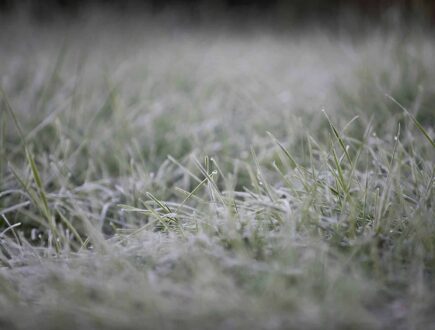Log in or create new account to save this product to your wishlist.

How to repair your lawn after the winter
Winter weather produces deteriorating living conditions for your lawn, and some of it can die off here and there - resulting in brown and bare spots. It’s quite normal to have to repair your lawn after the winter; this is standard practice for golf courses. The most effective way to rejuvenate a tired, overwintered lawn is to fertilise and overseed.
🌱 All important maintenance moments for your lawn during the year. Leave your email and we will send you the lawn calendar for free.
Enter your email
Receive the lawn calendar in the mail
Enjoy a green lawn all year round!

- Order by 2PM = shipped today
- 250.000+ satisfied customers!
- 60 day satisfaction guarantee
What happens to the lawn during winter?
The amount of sunlight decreases dramatically during the winter months. And when buildings, trees, and hedges restrict sunlight, shaded areas remain damp for months at a time. As a result, the individual grass plants begin to die off, causing bald patches that considerably thin out your lawn.
However, a mild winter can do as much damage to your lawn as a harsh, cold winter. Moss loves a cold, humid, shady climate, especially where temperatures are between 2- and 10-degrees.
A cold but dry winter offers your lawn the greatest chance of survival.
In 5 steps, you will enjoy a beautiful lawn again this spring:
- Start by removing leaves, branches, and any moss; a fertiliser with iron works wonders
- Aerate the turf by combing or scarifying the grass
- Sow new grass to fill in the gaps and keep weeds out
- Fertilise with a spring fertiliser with high nitrogen content
- Keep the grass seed moist for 3 weeks. New grass should germinate within 10 days.
Which grass seed do you use?
The choice of grass seed depends on your type of lawn.
- Shade & Sun Grass Seed: Ideal for shady lawns, but also suitable for full sun.
- Sport & Fun Grass Seed: For grass that can take a beating! Perfect for a lawn where children and pets play!
- Premium Lawn Grass Seed: For the enthusiast who wants a beautiful English lawn, which can also be cut short.
Timing is of the essence when sowing seeds!
The optimal time for sowing seed very much depends upon the conditions in your garden.
If hedges or buildings throw shade on parts of your lawn for most of the year, the soil’s temperature will be lower than in the rest of the garden. Therefore, you should avoid sowing too early in the year. Wait until the ground has reached at least 10-degrees before you start sowing!
Grass that grows around trees is best sown as soon as the temperature permits. That way, the lawn has enough time to establish itself before the trees’ foliage becomes dense, limiting the available light.
-
Zero-Waste Gardening – This is How You Do It!Did you know that the average person wastes between 100 and 150 kilos of food every year? That's why the concept of zero-waste gardening is becoming increasingly important for environmentally conscious gardeners that like to do their gardening greener.Read more
-
How to Master Tree Pollarding: A Practical GuidePretty dense! What might be an insult to some, is certainly a compliment to trees. Through pollarding, you can make sure, your trees have a dense crown of beautiful leaves.Read more
-
Get Ready: Here are 5 Garden Trends for 2025Curious about the latest garden trends for 2025? From smart solutions to sustainable choices, discover all the outdoor trends that are transforming British gardens!Read more
-
How to Care for Plants in Winter: A Simple GuideWhen winter comes around, the care requirements of your plants change. Find out, how to adjust the care routine for your plants.Read more
-
Companion Planting Made Easy: A Step-by-Step TutorialStrategic plant partnerships can solve common gardening problems like pest invasion and disappointing yields. Find out which plants are great together in our companion planting guide.Read more
-
How to Grow Sweet Potatoes in Your GardenWant to know something splendid? A single sweet potato plant can produce 5 to 10 pounds (4.54 kg) of nutritious tubers—plenty to keep your family’s pantry well-stocked for weeks!Read more
-
Revive Your Lawn After Winter With These Easy StepsTired of winter lawn damage? Discover how to repair brown spots, remove weeds, and revitalise your grass for a thriving garden this spring.Read more
-
A Complete Guide On Lighting for Your House PlantsAchieve perfect lighting for houseplants! This guide covers light mapping, plant placement, and grow light tips to help your plants flourish indoors.Read more
Leave a comment
Your answer will be displayed on the site and the interested party will be notified by email.
Leave a comment
Have a question or want to share your experience? Leave us a comment.

- Order by 2PM = shipped today
- 250.000+ satisfied customers!
- 60 day satisfaction guarantee

- Order by 2PM = shipped today
- 250.000+ satisfied customers!
- 60 day satisfaction guarantee

🌱 All important maintenance moments for your lawn during the year. Leave your email and we will send you the lawn calendar for free.
Enter your email
Receive the lawn calendar in the mail
Enjoy a green lawn all year round!






















Comments (0)
There are no comments yet. Well then, what are you waiting for to
Be the first to write your comment!inaugurate this pretty page?
Do you have some comments?